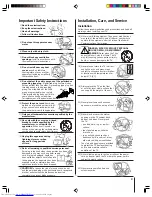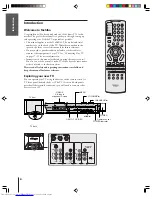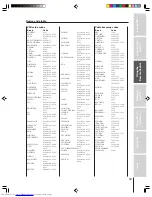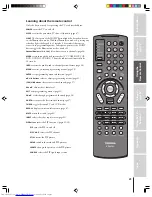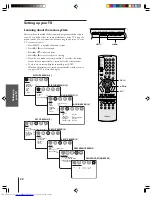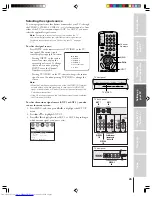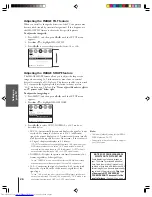
Intr
oduction
Connecting
y
our T
V
Using the
Remote Contr
ol
Setting up
y
our T
V
Using the T
V’s
F
eatur
es
Appendix
Index
12
Note:
•
For better picture quality, if your camcorder
has S-video, you can use an S-video cable
(plus the standard audio cables) instead of a
standard video cable.
•
Do not connect both a standard video cable
and an S-video cable at the same time, or
the picture performance will be
unacceptable.
Note:
•
When using an external audio amplifier, if
you set AUDIO OUT to VARIABLE, the
volume of both the TV and amplifier must
be set above 0 (zero) or you will not hear
any sound. See “Selecting fixed/variable
AUDIO OUT” on page 46.
•
If you set AUDIO OUT to VARIABLE, the
TV’s volume controls will adjust the volume.
If you set AUDIO OUT to FIXED, you must
use the amplifier’s volume controls
to adjust the volume. See “Selecting
fixed/variable AUDIO OUT” on page 46.
LINE IN
L
R
ANT( 75 )
ANT-1
OUT
ANT- 2
OUT
IN
S-VIDEO
VIDEO
VIDEO 1
VIDEO 2
L /
MONO
AUDIO
R
DVD IN
P
R
P
B
Y
COLOR
STREAM
INPUT
OUT
AUDIO CENTER
CHANNEL IN
L /
MONO
AUDIO
R
VIDEO
VAR/FIX
L
AUDIO
R
L
PIP AUDIO
R
ON
OFF
Amplifier
From Cable,
Cable Box,
or Antenna
TV
Connecting an audio system
This connection allows you to use an audio amplifier to adjust the
audio level, and to use external speakers.
To control the audio, turn on the TV and the stereo amplifier, and
turn off the built-in speakers. (See“Turning off the built-in speakers”
on page 45.)
You will need:
• one coaxial cable
• one pair of standard audio cables
DEMO
MENU
TV/VIDEO
VOLUME
CHANNEL
VIDEO-3 IN
VIDEO
S-VIDEO
L/MONO-AUDIO-R
VIDEO
AUDIO
OUT
L
R
Connecting a camcorder
This connection allows you to watch video materials recorded on a
camcorder.
You will need:
• one set of standard A/V cables
Camcorder
TV front panel



